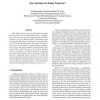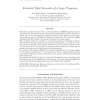1578 search results - page 227 / 316 » Induction of Stable Models |
FTCS
1998
14 years 10 hour ago
1998
Most fault-tolerant systems are designed to stop faulty programs before they write permanent data or communicate with other processes. This property (halt-on-failure) forms the co...
CORR
2008
Springer
13 years 10 months ago
2008
Springer
Compressive sensing (CS) is an emerging field based on the revelation that a small collection of linear projections of a sparse signal contains enough information for stable, sub-N...
ECAI
2010
Springer
13 years 11 months ago
2010
Springer
Logic programs under the stable models semantics, or answer-set programs, provide an expressive rule based knowledge representation framework, featuring formal, declarative and wel...
HPCA
2005
IEEE
14 years 11 months ago
2005
IEEE
This paper studies the impact of L2 cache sharing on threads that simultaneously share the cache, on a Chip Multi-Processor (CMP) architecture. Cache sharing impacts threads non-u...
ICLP
2010
Springer
14 years 2 months ago
2010
Springer
We define the Tight Semantics (TS), a new semantics for all NLPs complying with the requirements of: 2-valued semantics; preserving the models of SM; guarantee of model existence...


